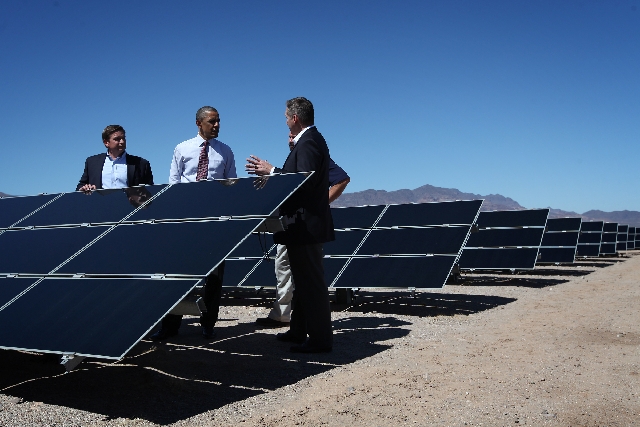Jobs, costs at heart of debate

Maybe an old-fashioned cage match would settle it.
Two local groups released dueling studies this week on the costs and benefits of Nevada’s renewable portfolio standard, a state law that requires power utility NV Energy to obtain 25 percent of its electricity from renewable sources such as solar and geothermal by 2025.
In one corner sits the Nevada Policy Research Institute, a libertarian think tank that says the portfolio standard will slice nearly 2,000 jobs from the state’s economy in 2025, as power prices jump 6 percent on average and ratepayers’ power bills surge $174 million.
Across the ring, green power advocate Clean Energy Project contends that not only is the standard good for Nevada, but strengthening it would create as many as 42,151 full-time jobs in a given year from 2014 through 2040, generating up to $4.6 billion in wages and $12.3 billion in economic output.
So who’s right?
The truth may be somewhere in the middle, said Mark Muro, a senior fellow with the Brookings Institution and director of policy for the think tank’s Metropolitan Policy Program.
“One can take with a grain of salt both any exaggerated job claims and job-damage projections,” said Muro, who has researched green power job creation. “It’s a testimony to the complexity of these analyses and the continuing sort of overheated ideological posturing around this issue.”
But there’s no posturing here, said Geoffrey Lawrence, deputy director of the Nevada Policy Research Institute.
Rather, the institute’s study, conducted with Massachusetts free market group Beacon Hill Institute, shows what happens when you swap out conventional fossil fuels with less efficient renewables, Lawrence said. If you average out the cost of construction, fuel, transmission and every other expense of putting together and running a green power plant, it’s substantially more expensive per kilowatt hour than fossil fuels.
That has two big economic consequences. First, higher power rates make the state less attractive to companies that might want to operate here. Second, when consumers spend more on power, they have less for other goods and services.
Crunch the numbers, and business investment in Nevada could drop by $9 million to $47 million in 2025, while disposable income could fall by $72 million to $373 million. Power bills would rise an average of $70 a year for households, $400 a year for commercial businesses and $26,220 for industrial operations.
But Lydia Ball, executive director of the Clean Energy Project, said that analysis has one multibillion-dollar problem: It doesn’t include money ratepayers fork over to buy natural gas and coal to fuel power plants. That amount was $1.7 billion in 2008, and $1.3 billion in 2010 and 2011 combined.
That cash goes to out-of-state providers. Replacing it with state-generated green power would mean investments that keep money local, in the form of property taxes and wages.
That’s why the Clean Energy Project advocates expanding the state’s portfolio standard. In the group’s ultimate scenario, with numbers crunched by research firm Applied Analysis, a revised law would cut energy efficiency credits from the standard and raise the green-energy requirement to 35 percent of NV Energy’s portfolio by 2025.
The project says those changes would spur construction of new projects, which would create thousands of direct building jobs, as well as indirect jobs as laborers spend wages in the local economy.
Both Lawrence and Ball had issues with each other’s findings. The Clean Energy Project doesn’t look at lost business investment, Lawrence said. And the Nevada Policy Research Institute used “tunnel vision” when it chose esoteric data models, Ball responded.
Muro quibbled with both, though he was harder on the Nevada Policy Research Institute’s work. He called the study part of a nationwide effort to undermine portfolio standards by detractors who see clean power as a “socialist onslaught.” Plus, the institute rejected “universally authoritative” federal numbers on renewable costs, and adopted separate numbers at a higher basis.
But while Muro said he is “very bullish” on green technologies, it’s not because they are big job creators.
“Construction jobs are a one-time thing, and it doesn’t take a lot of people to operate a solar farm,” he said.
Instead, Muro said, the state should ramp up renewables to diversify its energy sources and protect ratepayers from ups and downs in fossil-fuel prices.
State consumer advocate Eric Witkoski, who represents the public in utility rate cases, said his office is concerned about, and is monitoring, the effects of the portfolio standard. He said NPRI’s analysis of $2.28 billion in economic impact over 12 years is close to the number his office has calculated.
Still, Witkoski said, it’s important to consider not only how much less discretionary income ratepayers might have from renewables, but also how much more ratepayers might spend on out-of-state fuel buys.
The Legislature seems to have taken the Clean Energy Project’s side.
Senate Bill 252 doesn’t boost the standard beyond 25 percent, but it does phase out energy efficiency and solar-power incentives that Ball said warp the green-power market.
The bill passed the Senate unanimously Tuesday and has gone to the Assembly for consideration.
Contact reporter Jennifer Robison at jrobison@review journal.com or 702-380-4512. Follow @J_Robison1 on Twitter.












